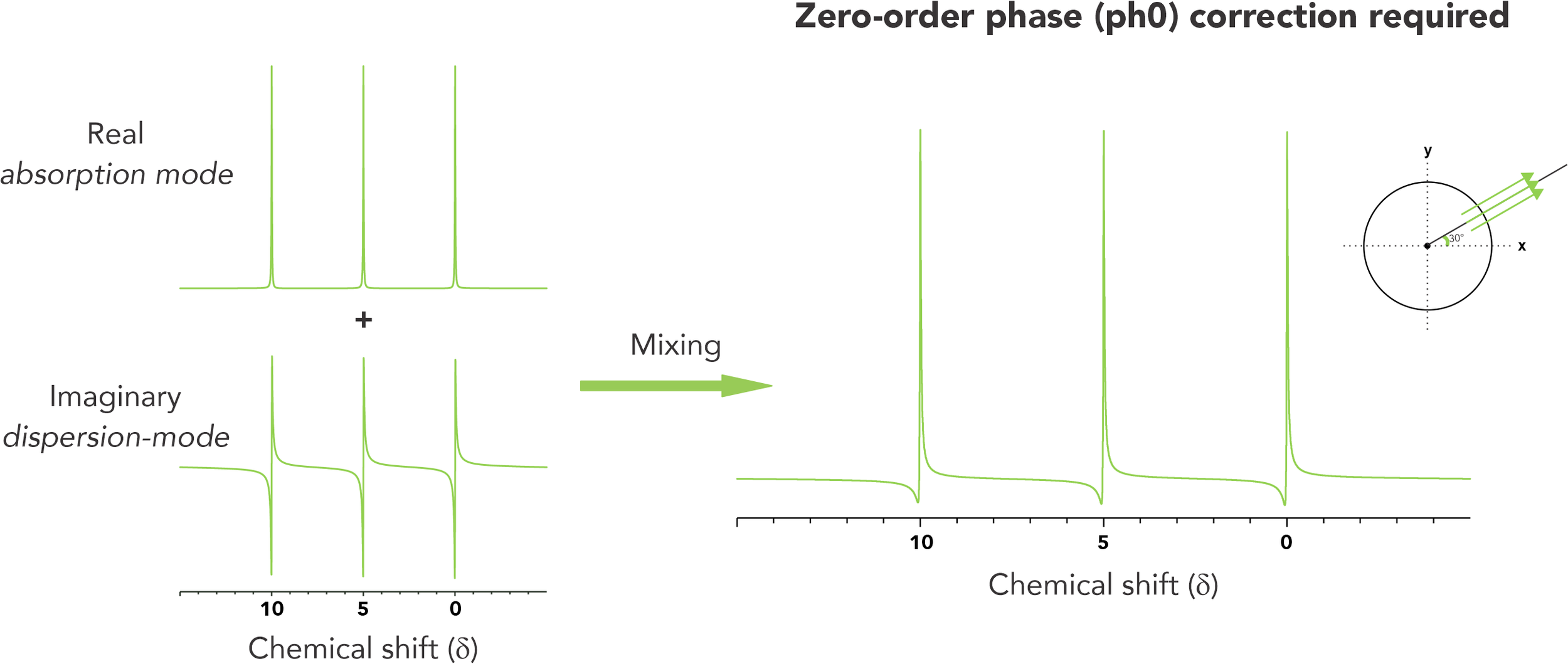NMR data processing: Phase Correction
Most NMR users know that phase correction is a very important adjustment that needs to be made to a spectrum. Practically speaking, the phase of a signal is related to the amount of signal observed above and below the baseline. Phase correction works to provide a signal in pure-absorption mode, which means a signal totally above and/or totally below the baseline (e.g. DEPT-135).
Phase correction involves adjusting both zero (ph0) and first-order (ph1) phases. The zero-order phase arises because the relative phase of the transmitter pulse and receiver are offset. This results in a mixing of the desired real part of the spectrum with a portion of the corresponding imaginary part, so one side of the base of each peak is observed to dip below the baseline (Figure 1). Zero-order phase correction undoes this mixing. The zero-order phase shift affects all frequencies in the same way, and is said to be frequency-independent.
Figure 1: Example of a spectrum with a zero-order phase shift of 30° as a result of a mixing of the desired real part with a portion of the corresponding imaginary part. All signals show the same phase distortion.
On the other hand, first-order phase shift leads to a frequency-dependent phase distortion (Figure 2). Delays during pulse sequence and detection process give rise to a phase distortion that is proportional to the chemical shift. In cases where these delays are small compared to the frequency offset, the phase error can be corrected. Otherwise, in the presence of large delays, this correction will introduce baseline distortions (rolling baseline).
Figure 2: Example of a spectrum with a first-order phase shift. The phase error is frequency-dependent; the greater the offset in relation to the pivot point, the greater the phase error.
How should the user correct the phase of a spectrum? Most of the time, automatic phase correction works well, but in special cases, such as in spectra with a low signal-to-noise ratio, it can lead to bizarre values of ph1. If this is your case, reset the correction values and perform a manual phase correction. Choose a strong peak in one extreme of the spectrum as the pivot. Adjust the zero-order phase to get the pivot signal in pure-absorption mode, and then adjust the first-order correction until the signal at the other end of the spectrum is in pure-absorption mode. To fine-adjust the phase (Figure 3), it is recommended to zoom the spectrum vertically and pay attention to the bases of the peaks, as they should be symmetric on both sides.
Figure 3: Illustration of phase correction after a vertical zoom in the spectrum; a) and c) need more correction. b) ideal correction, as the peak’s base is symmetric on both sides.
For more information about our 100, or 60 MHz benchtop NMR spectrometer, or options for advanced experiments or pulse programming capabilities through SPINit, please contact sales@nanalysis.com or fill out this form.
References:
[1] https://nmr.chem.ucsb.edu/education/part1.html#phasing
[2] https://www.nmr.chemistry.manchester.ac.uk/sites/default/files/NMR%20data%20processing.pdf
[3] Chapter 3, topic 3.2.8, from T. D. W. Claridge, High-Resolution NMR Techniques in Organic Chemistry (3th edition, Elsevier, 2016).
[4] Chapter 3, topic 3.12.1, from N.E. Jacobsen, NMR SPECTROSCOPY EXPLAINED (John Wiley & Sons, 2007).



